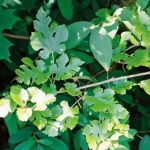| Common Name: |
White Mulberry |
| Botanical Name: |
Morus Alba |
| Genus: |
Morus |
| Family: |
Moraceae |
| Native Location: |
China |
| Cultivation: |
Rich, deep, well-drained soil in sun. Mulberries have brittle roots and need careful handling when planting. Prune only when fully dormant in winter beause mulberries bleed when cut. Ideally prune only badly placed branches and dead wood. Canker and dieback may damage young shoots.. |
| Propagation: |
By seed sown in autumn (species only); by softwood cuttins in summer, or hardwood cuttings in autumn. |
| Harvest: |
For medicinal use, leaves are collected after frost in autumn, branches in late spring or summer, roots in winter, and fruits when nearly ripe. Leaves and root bark are traditionally processed with honey. Fresh leaves and fruits are sometimes juiced but otherwise all parts are dried, for use in decoctions or poultices. Fruits may be steamed or blanched before drying to improve storage qualities; for culinary use they are harvested when ripe. |
| Height: |
20m (70ft) |
| Width: |
10m (30ft) |
| Variations: |
Pendula
Has a weeping habit.
Height: 3m (10ft)
Width: 5m (15ft) |
| Hardiness: |
Z4-9 |
| Parts Used: |
Leaves (sang ye), branches (sang zhi), root bark (sang bai pi), fruits (sang shen). |
| Properties: |
A pleasant-tasting, bitter or sweet herb (depending on the part). It increases perspiration rate and has anti-bacterial, cooling effects (leaves), is anti-rheumatic (branches), controls coughing, is expectorant and diuretic (root bark), and has a tonic effect on kidney energy (fruits). Both root bark and branches reduce blood pressure. |
| Medicinal Uses: |
Internally for colds, influenza, eye infections, and nosebleeds (leaves); rheumatic pains and hypertension (branches); coughs, asthma, bronchitis, edema, hypertension, and diabetes (root bark); urinary incontinence, tinnitus, premature graying of hair, thirst, constipation in the elderly (fruits). |
| Culinary Uses: |
Fruits are dried, or eaten fresh and made into jellies, jams, syrup and wine. |
| Economic Uses: |
Leaves are fed to silkworms. Wood is used in aging balsamic vinegar, and in the manufacture of sports equiptment, such as tennis rackets and bats, especially in India. |
| Bibliography: |
Encyclopedia of Herbs by Deni Brown Copyright © 1995, 2001 Dorling Kindersley Limited. pg 222 |
